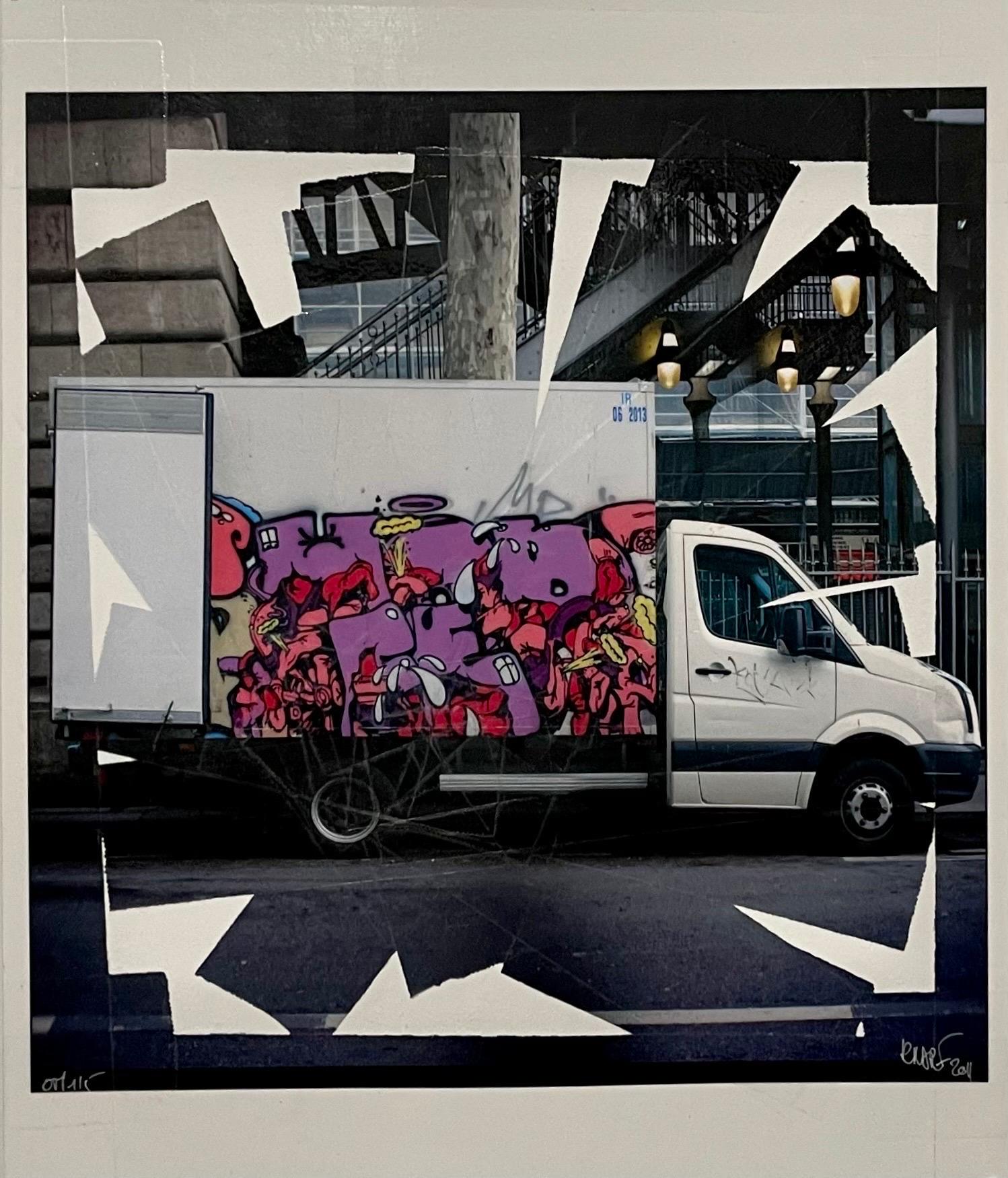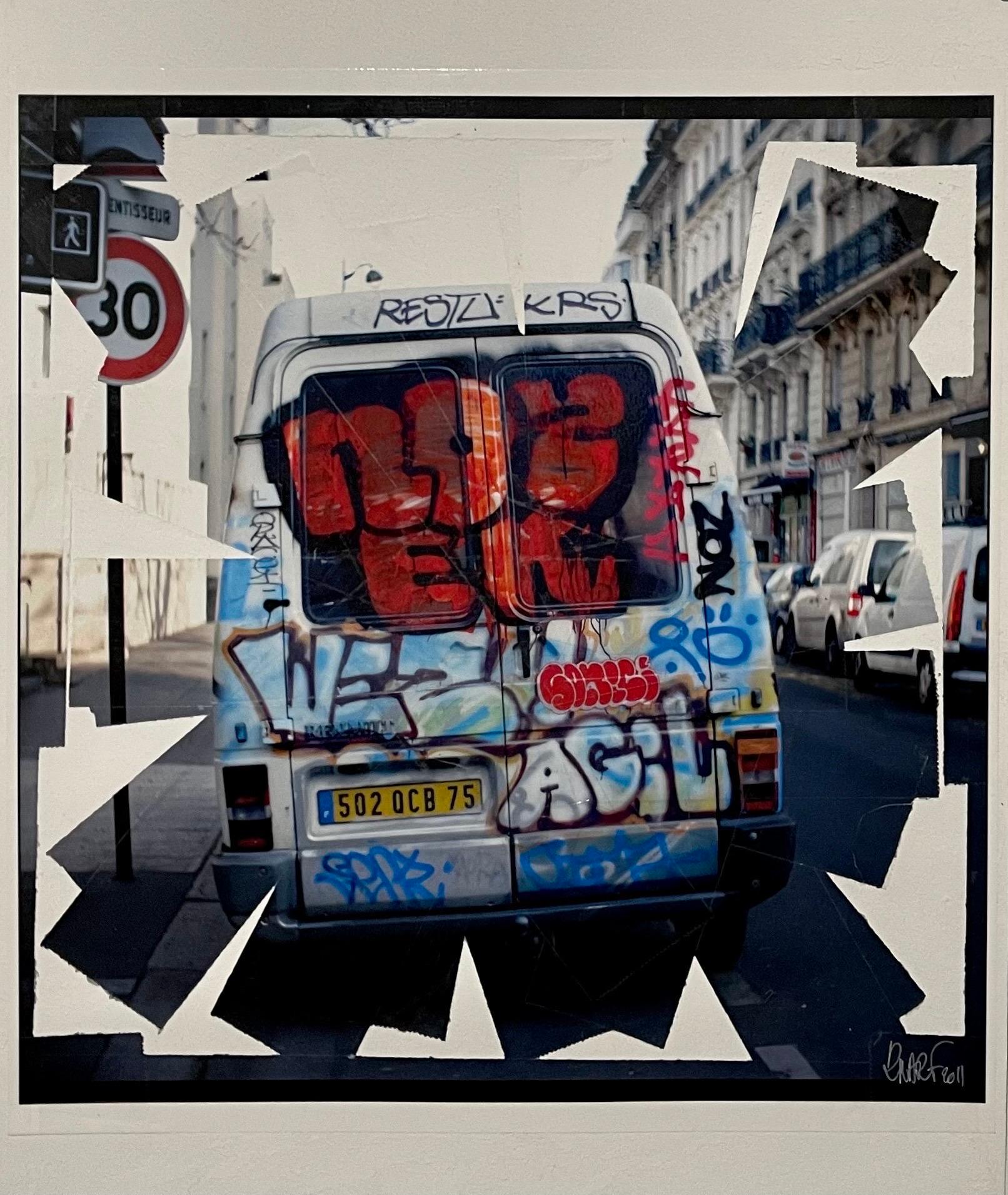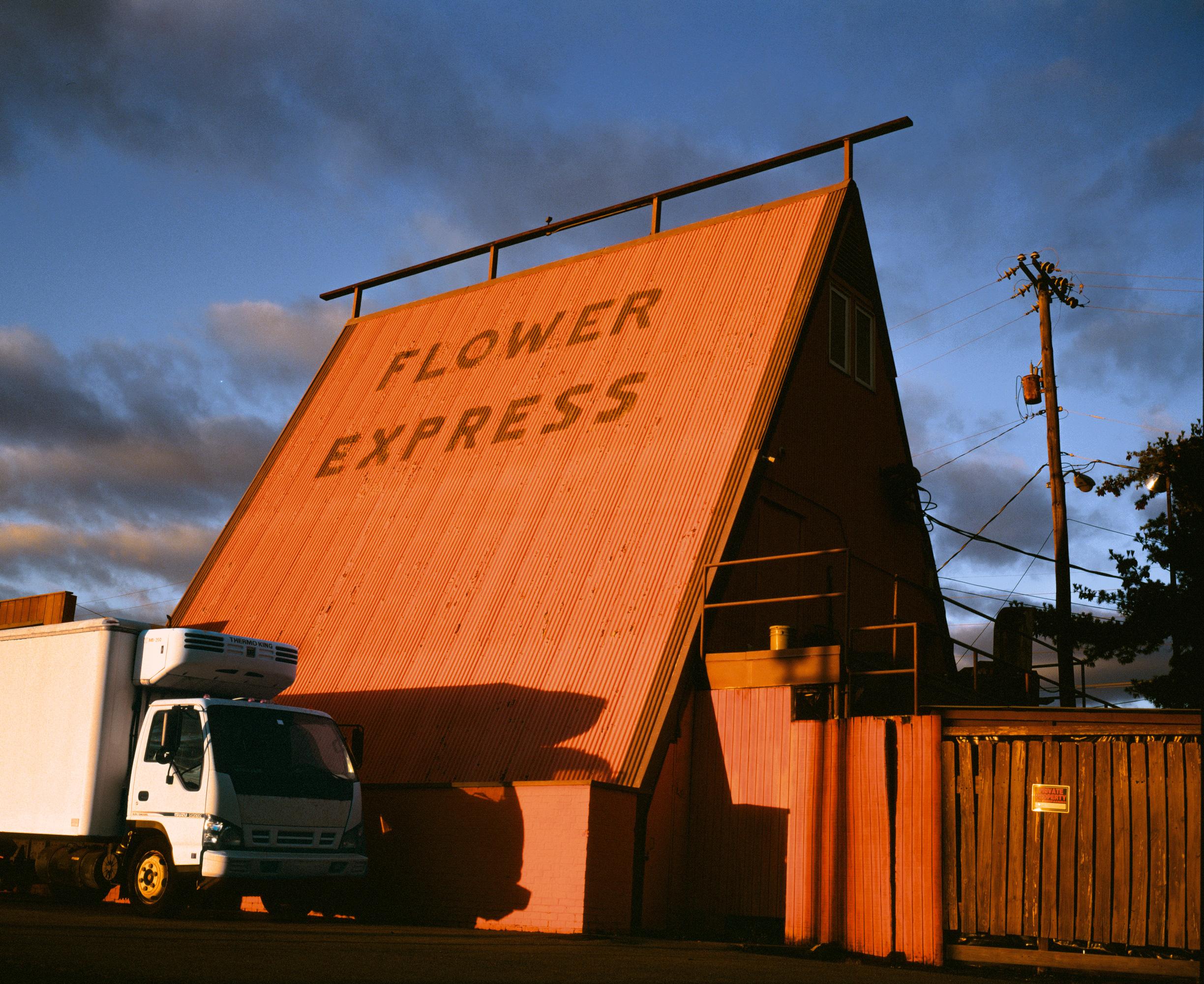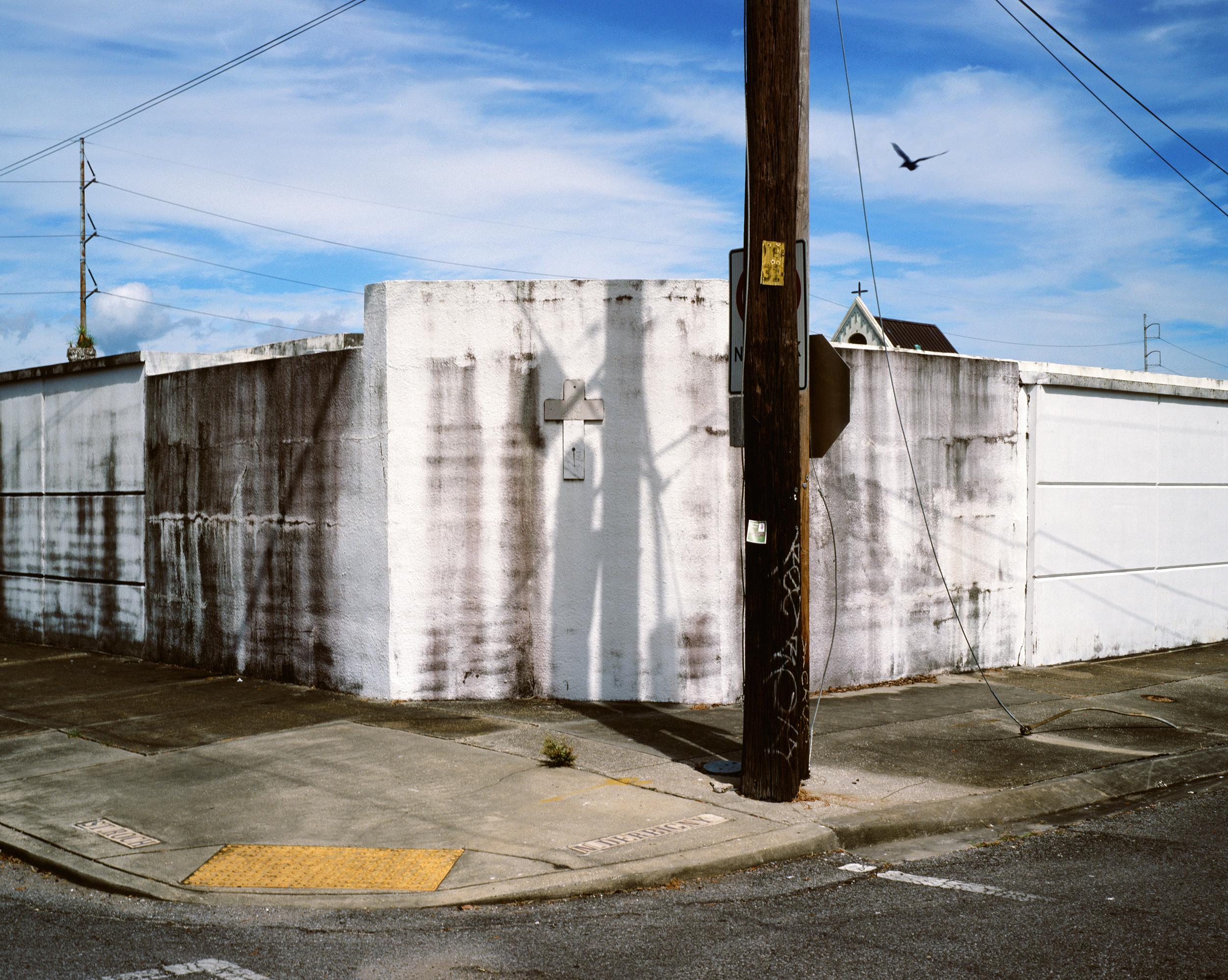Items Similar to K-Narf Color Photo Graffiti, Adhesive Tape Altered Street Art Photograph Collage
Want more images or videos?
Request additional images or videos from the seller
1 of 17
K-NarfK-Narf Color Photo Graffiti, Adhesive Tape Altered Street Art Photograph Collage
About the Item
K-narf, French (b. 1970)
Collage photo artwork (Graffiti Vans) (2011)
Tape-o-graph photography
Signed lower right, numbered 1/5
16 x 12 7/8 inches
K-NARF was born in 1970 in Saint-Etienne, France and now lives in Tokyo.
K-NARF invented PHOTOGRAFFITI a contemporary way of making street photography that lead him to develop his singular Tape-o-Graphy technique. It involves the application of adhesive tape strips on developed photographs in order to manually process the photographs giving them a unique surface texture and extraordinary appearance.
Open to influences from street art and video, he uses the medium of photography as a toy to create and play. Both conceptual and experimental, definitely non-conventional, his work documents, recycles and collects the visual anachronisms of a world in a perpetual mutation. Through the years, K-narf often got support from key figures of the art world such as Teruo Kurosaki (Idee, Tokyo), Rotraut and Daniel Klein-Moquay (Yves Klein Estate), Joel Meyerowitz (pioneer of contemporary color photography), Jacques Attali (French writer), Olivier Gay (Architect & Art collector) and Yoichi Nakamuta (curator & Art producer). He collaborates on regular basic with established Art galleries including the Clic gallery in NYC, the 0fr gallery and Molin Corvo gallery in Paris or the Clear gallery in Tokyo. He moved back to Tokyo early 2014 and created his own gallery/atelier in the heart of the Nakameguro.
For the past decade K-narf has lived and exhibited worldwide including Japan, Australia, France, Singapore, USA and Italy. His exhibitions, often taking the form of ephemeral installations, are shown without distinction in a plant still in operation, an old theatre, Art galleries, Art biennales or an abandoned garage. His work has been shown atthe Museum of Contemporary Art in Scottsdale (US), the Museum of Sydney, the Japan Foundation for the Arts, The Yves Klein Archives, Agnes B, Pierre Herme, Issey Miyake (Paris), the Clic gallery in NYC as well as a solo show during the Arles photo festival. K-NARF has exhibited his “photograffiti” installations in unlikely locations such as old cinemas, functioning plants, and abandoned garages. But he’s no street art snob. He has also shown his work at the French Embassy in Tokyo, the Museum of Sydney, and a photo festival in Arles, France. His career was launched back in 2001 when an artist named Teruo Kurosaki gave K-NARF — then a practicing architect — his first exhibition, The Red and Newspapers, at Sputnik PAD in Tokyo, Japan. Since then, he has been honing his creations and is seemingly primed to join the neo-pop ranks of cynical self-merchandising artists Jeff Koons and Takashi Murakami.
K-Narf Photograffiti was exhibited at Clic Gallery NYC; kitschy photographs of amusement parks from the ’80s that he then altered with adhesive tape. French artist K-NARF transformed the concept of hatarakimono into a stunning series of works, photographing Japan’s everyday workers on the street in their work clothes. Using a portable background, he created an identical structure for all of the images. He posed bus drivers, souvenir shop cashiers, and udon cooks on a small pedestal in front of a gray background. The result is stunning: K-NARF has created a multi-faceted monument to the workers. With the HATARAKIMONO, K-NARF picks up right in the famous footsteps of of photographers Felix Thiollier, August Sander or Irving Penn. K-NARF & SHOKO go against the grain and shows Japan’s traditional workers in their everyday outfits without special clothing or make-up. They do not use filters to iron out the wrinkles in their suits or faces. When selecting the unusual format for the project, the artist took inspiration from an old photo art tradition. The portraits are reminiscent of the carte de visite, a kind of small photographic calling card from the 1860s that helped photography make major breakthroughs in popularity. Knarf describes himself as an artist pretending to be a photographer. He is self-taught in the art and craft of photography. As a 15 year-old, he installed a makeshift darkroom in his parents’ bathroom to develop his first black-and-white photos. In 1996, after he acquired one of the first digital camera, he started a new approach to photography blending up-coming technologies together with manual processing techniques. He had his first exhibition in Tokyo in 2001 and in 2005 IdN, Hong-Kong publisher, released NEO-PHOTO a book dedicated to his work. K-NARF met SHOKO in Tokyo in 2014, they started working together in 2016 with the HATARAKIMONO PROJECT. It was first presented in 2018 at the Kyotographie International Photography Festival. This work owes a debt to Arte Povera and Bricolage a French form of collage (ala Tom Sachs),
BIO
1970 Born in Saint-Etienne, France
2001 move to Tokyo, first exhibition in Japan at SPUTNIK-IDÉE in Tokyo
2006 invited to be one of the 40 first members of the prestigious “HP Influencers program”. (He is the youngest member on the side with MAGNUM photographers and other established photographers such as Joel Meyerowitz)
2007 solo exhibition at the Rencontres d’Arles international photo festival
2008 invents PHOTOGRAFFITI as a new street photography approach and start pasting them in the streets of
Tokyo, Paris, Milan, Rome, NYC
2010 starts making his first large format TAPE-O-GRAPHS
2011 first exhibition in the USA, CLIC Gallery NYC
2014 move back his studio to Tokyo and meet SHOKO
2016 Began working on the HATARAKIMONO project together with japanese artist, Shoko Yamaguchi
2018 HATARAKIMONO PROJECT book co-published with DILECTA Editions, Paris
2019 started the “PLASTÉONTOLOGY PROJECT” in collaboration with TARA OCEAN FOUNDATION (Agnès b)
2020 K-NARF & SHOKO moved their studio from Tokyo to Kyoto
- Creator:K-Narf (1971, American)
- Dimensions:Height: 16 in (40.64 cm)Width: 12.88 in (32.72 cm)
- Medium:
- Movement & Style:
- Period:
- Condition:
- Gallery Location:Surfside, FL
- Reference Number:1stDibs: LU38210135432
About the Seller
4.9
Platinum Seller
These expertly vetted sellers are 1stDibs' most experienced sellers and are rated highest by our customers.
Established in 1995
1stDibs seller since 2014
1,560 sales on 1stDibs
Typical response time: 1 hour
- ShippingRetrieving quote...Ships From: Surfside, FL
- Return PolicyA return for this item may be initiated within 3 days of delivery.
More From This SellerView All
- K-Narf Color Photo Graffiti, Adhesive Tape Altered Street Art Photograph CollageBy K-NarfLocated in Surfside, FLK-narf, French (b. 1970) Collage photo artwork (Graffiti Vans) (2011) Tape-o-graph photography Signed lower right, numbered 1/5 16 x 12 7/8 inches K-NARF was born in 1970 in Saint-Etienne, France and now lives in Tokyo. K-NARF invented PHOTOGRAFFITI a contemporary way of making street photography that lead him to develop his singular Tape-o-Graphy technique. It involves the application of adhesive tape strips on developed photographs in order to manually process the photographs giving them a unique surface texture and extraordinary appearance. Open to influences from street art and video, he uses the medium of photography as a toy to create and play. Both conceptual and experimental, definitely non-conventional, his work documents, recycles and collects the visual anachronisms of a world in a perpetual mutation. Through the years, K-narf often got support from key figures of the art world such as Teruo Kurosaki (Idee, Tokyo), Rotraut and Daniel Klein-Moquay (Yves Klein Estate), Joel Meyerowitz (pioneer of contemporary color photography), Jacques Attali (French writer), Olivier Gay (Architect & Art collector) and Yoichi Nakamuta (curator & Art producer). He collaborates on regular basic with...Category
Early 2000s Street Art Color Photography
MaterialsAdhesive, Tape, Mixed Media, Photographic Paper
- K-Narf Color Photo Graffiti, Adhesive Tape Altered Street Art Photograph CollageBy K-NarfLocated in Surfside, FLK-narf, French (b. 1970) Collage photo artwork (Graffiti Vans) (2011) Tape-o-graph photography Signed lower right, (this one is not editioned and might be unique. the other 2 I have were from an edition of 5) 16 x 12 7/8 inches K-NARF was born in 1970 in Saint-Etienne, France and now lives in Tokyo. K-NARF invented PHOTOGRAFFITI a contemporary way of making street photography that lead him to develop his singular Tape-o-Graphy technique. It involves the application of adhesive tape strips on developed photographs in order to manually process the photographs giving them a unique surface texture and extraordinary appearance. Open to influences from street art and video, he uses the medium of photography as a toy to create and play. Both conceptual and experimental, definitely non-conventional, his work documents, recycles and collects the visual anachronisms of a world in a perpetual mutation. Through the years, K-narf often got support from key figures of the art world such as Teruo Kurosaki (Idee, Tokyo), Rotraut and Daniel Klein-Moquay (Yves Klein Estate), Joel Meyerowitz (pioneer of contemporary color photography), Jacques Attali (French writer), Olivier Gay (Architect & Art collector) and Yoichi Nakamuta (curator & Art producer). He collaborates on regular basic with...Category
Early 2000s Street Art Color Photography
MaterialsAdhesive, Tape, Mixed Media, Photographic Paper
- 1970s Mona Lisa Photo Collage Photograph Pioneer Female Aviator Feminist Pop ArtBy Vera SimonsLocated in Surfside, FLThis one Mona Lisa, some with glasses drawn on, cut and torn newspaper, collage, assemblage and looks like a Guerrilla Girl ad in a pattern and decoration style. It is not signed or ...Category
1970s Assemblage Color Photography
MaterialsMixed Media, Newsprint, Photographic Paper
- Vintage Color Photograph Kadishman Sculpture Jerusalem Museum Marc Riboud PhotoBy Marc RiboudLocated in Surfside, FLThis is a vintage Marc Riboud photo of a Menashe Kadishman sculpture in the Billy Rose sculpture garden at the Israel Museum. Hand signed and editioned. This is for one Photograph from the portfolio entitled "Jerusalem: City of Mankind," The mounting is 14 X 17 inches. the actual photo measurement is between 9.25 X 14 to 10.5 X 13.5 inches (22.9 X 35.6 to 26.7 X 34.3 cm.) This is hand signed and editioned in pencil, on print mount recto; and stamped on the reverse with photographers name and copyright info. In a folding jacket with a printed credit and title. The first copy was awarded to the President of the United States, the second to the President of the State of Israel, the third to the Mayor of Jerusalem and the fourth to the Baron Edmond de Rothschild. Rare Cornell Capa and Baron Edmond De Rothschild “Jerusalem: City Of Mankind” Photo Album 1973. It has been produced by the international fund for concerned photography, INC, New York for the women’s division of the American Friends of the Israel Museum, New York. 15 copied were reserved for participating photographers. Color prints are made by dye transfer process from original transparencies and black and white enlargements are made from original negatives under the photographers supervision. Design and production – Arnold Skolnick / Bhupendra Karia. Color prints by Berkey K & L Custom Services INC, New York. Black and white prints by Igor Bakht Werner Braun – Moonrise over the Knesset Robert Burroughs – At the Western Wall. Cornell Capa – View from the Israel Museum sculpture garden. Leonard Freed – Reading from Sephardic Torah scrolls. Ernst Haas – In the Arab quarter, Old City. Charles Harbutt – Easter, Holy fire. Ron Havilio – Wallscape. Bhupendra Karia – Midday prayers, Al Aqsa grounds. Marc Riboud – Ecumenical landscape Billy rose garden, Israel museum. Ted Spiegel – Benedictine nun, Mount of Olives. Micha Bar-Am – Via Dolorosa on Friday. Marc Riboud (French: 1923 – 2016) was a French photographer, best known for his extensive reports on the Far East: The Three Banners of China, Face of North Vietnam, Visions of China, and In China. Riboud was born in Saint-Genis-Laval and went to the lycée in Lyon. He photographed his first picture in 1937, using his father's Vest Pocket Kodak camera. As a young man during World War II, he was active in the French Resistance, from 1943 to 1945. After the war, he studied engineering at the École Centrale de Lyon from 1945 to 1948. He moved to Paris where he met Henri Cartier-Bresson, Robert Capa, and Chim, David Seymour, the founders of Magnum Photos. By 1953 he was a member of the organization. His ability to capture fleeting moments in life through powerful compositions was already apparent, and this skill was to serve him well for decades to come. Over the next several decades, Riboud traveled around the world. In 1957, he was one of the first European photographers to go to China, and in 1968, 1972, and 1976, Riboud made several reportages on North Vietnam. Later he traveled all over the world, but mostly in Asia, Africa, the U.S. and Japan. Riboud has been witness to the atrocities of war (photographing from both the Vietnam and the American sides of the Vietnam War), and the apparent degradation of a culture repressed from within (China during the years of Chairman Mao Zedong's Cultural Revolution). In contrast, he has captured the graces of daily life, set in sun-drenched facets of the globe (Fès, Angkor, Acapulco, Niger, Bénarès, Shaanxi), and the lyricism of child's play in everyday Paris. In 1979 Riboud left the Magnum agency. Riboud's photographs have appeared in numerous magazines, including Life, Géo, National Geographic, Paris Match, and Stern. He twice won the Overseas Press Club Award, received the Lifetime Achievement Award at the 2009 Sony World Photography Awards and has had major retrospective exhibitions at the Musée d'Art Moderne de la Ville de Paris and the International Center of Photography in New York. Riboud was made an Honorary Fellow of the Royal Photographic Society in 1998. One of Riboud's best known images is Eiffel Tower Painter, taken in Paris in 1953. It depicts a man painting the tower, posed like a dancer, perched between the metal armature of the tower. Below him, Paris emerges from the photographic haze. Lone figures appear frequently in Riboud's images. In Ankara, a central figure is silhouetted against an industrial background, whereas in France, a man lies in a field. The vertical composition emphasizes the landscape, the trees, sky, water and blowing grass, all of which surround but do not overpower the human element. An image taken by Riboud on 21 October 1967, entitled "The Ultimate Confrontation: The Flower and the Bayonet," is among the most celebrated anti-war pictures. Shot in Washington, D.C. where thousands of anti-war activists had gathered in front of the Pentagon to protest against America's involvement in Vietnam. Select Exhibitions 1958 Photographs From The Museum Collection (Museum of Modern Art, New York) 1959 30th Anniversary Special Installation - Towards the "New" Museum (Museum of Modern Art) 1960...Category
1960s Modern Color Photography
MaterialsPhotographic Paper, C Print, Color
- Sports Watch Abstract Photo Mosaic Collage Aerial Photograph Feminist AviatorBy Vera SimonsLocated in Surfside, FLThis one depicts a sports wristwatch over an aerial city or field landscape and is titled "Time Frame". It is signed and dated. I believe it might be Amsterdam or London. SIMONS, Ver...Category
1970s Assemblage Color Photography
MaterialsPhotographic Paper
- Wrist Watch Abstract Photo Mosaic Collage Aerial PhotographBy Vera SimonsLocated in Surfside, FLThis one depicts a sports wristwatch over an aerial landscape and is titled Clock Garden. it is signed and dated 1979. SIMONS, Vera (1920 - 2012) Vera Habrecht Simons, was a German/...Category
1970s Assemblage Color Photography
MaterialsPhotographic Paper
You May Also Like
- Patrick Sansone, Ideal and Bird, 2021, Lambda C Print, Ed 1/10, PhotographyLocated in Darien, CTPatrick Sansone uses analog cameras and film to create photographs that reference stillness, lure, and intermission. Decaying signage, abandoned industrial sites, and defunct storefr...Category
2010s Street Art Color Photography
MaterialsArchival Paper, Photographic Paper, C Print, Color, Lambda
- Patrick Sansone, Flower Express, 2022, Lambda C Print, Ed 1/10, PhotographyLocated in Darien, CTPatrick Sansone uses analog cameras and film to create photographs that reference stillness, lure, and intermission. Decaying signage, abandoned indust...Category
2010s Street Art Color Photography
MaterialsArchival Paper, Photographic Paper, C Print, Color, Lambda
- Patrick Sansone, St. Roch and Bird, 2022, Lambda C Print, Ed 1/10, Street PhotoLocated in Darien, CTPatrick Sansone uses analog cameras and film to create photographs that reference stillness, lure, and intermission. Decaying signage, abandoned industrial sites, and defunct storefr...Category
2010s Street Art Color Photography
MaterialsArchival Paper, Photographic Paper, C Print, Color, Lambda
- Patrick Sansone, Greenwood Sprite, 2021, Lambda C Print, Ed 1/10, Street PhotoLocated in Darien, CTPatrick Sansone uses analog cameras and film to create photographs that reference stillness, lure, and intermission. Decaying signage, abandoned industrial sites, and defunct storefr...Category
2010s Street Art Color Photography
MaterialsArchival Paper, Photographic Paper, C Print, Color, Lambda
- Patrick Sansone, Sue's Window, 2021, Lambda C Print, Ed 2/10, Street PhotographyLocated in Darien, CTPatrick Sansone uses analog cameras and film to create photographs that reference stillness, lure, and intermission. Decaying signage, abandoned industrial sites, and defunct storefr...Category
2010s Street Art Color Photography
MaterialsArchival Paper, Photographic Paper, C Print, Color, Lambda
- Patrick Sansone, Christlike, 2023, Lambda C Print, Ed 1/10, Street PhotographyLocated in Darien, CTPatrick Sansone uses analog cameras and film to create photographs that reference stillness, lure, and intermission. Decaying signage, abandoned indust...Category
2010s Street Art Color Photography
MaterialsArchival Paper, Photographic Paper, C Print, Color, Lambda
Recently Viewed
View AllMore Ways To Browse
Hermes Color
Nyc Streets Photography
French Street Names
Nyc Street Sign
Japanese Street Art
Garage Art
Paris Color Photographs Large
Recycled Paper Art
Signed Photo Nyc Street
Hermes Art Work
Photo Strip
80s Pop Art
Photographs Penn
Hermes Art Gallery
Graffiti Photography
Small Art Pedestal
Hong Kong Photo
Penn Photos




